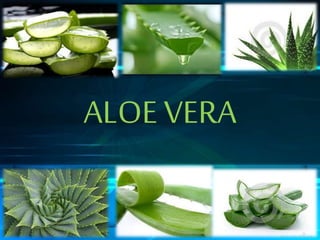
Aloe vera
- 1. ALOE VERA
- 2. SPECIES INFORMATION Scientific name: AloeVera(L.) Burm.f. Common name: aloe Vera Conservation status: Not considered to be threatened. Habitat: AloeVera is acultivated plant but naturalised populations occur in dry, often rocky and exposed areas. Key Uses: Food, food supplements, herbal remedies and cosmetics Known hazards: The bitter yellow leaf exudates can be harmful and should not be taken by children, or by pregnant or breastfeeding women. The colourless leaf parenchyma (gel) can occasionallycause skinirritation.
- 4. What is Aloe Vera? The Aloe Vera plant is a succulent perennialand a species of plantbelongingto theLily family which is part of a larger familyof plants known as "Xeroids". Of the known medicinalAloes, Aloe Barbadensis Miller has theGreatest medicinal activity and is theonly Aloe bearing the botanical name Aloe Vera, Vera meaning true in Latin,Thus "True Aloe" or "Aloe Vera".
- 5. DESCRIPTION AloeVeraisa short-stemmedshrubby aloe,frequently suckering andformingdense clumps.Theleaves are succulent,erect,forminga denserosette.Theleaves are greyish green,growing toabout50 cmlong,withmarginsthat are pinkishwith manysmallspines.The leafsurfacesare sometimesmarkedwithwhiteflecksor spots.Theflowersare yellow,tubular, andup to3 cm long,with anthersand stigma protruding.Theflowersare borne in cylindrical racemesona branched panicleup to90cm tall. AloeVerawas formerlyclassifiedas partofthe Asphodelaceaefamily,but thisis now includedin Xanthorrhoeaceae.
- 6. CULTIVATION AloeVerais easy to cultivate, withno special requirements.It should be grown in a well-draining gritty mix.The compost should be soaked when wateringduringthegrowing season, and allowed to dry out between waterings. It can be grown in a cool/warm glasshouseand put outside for the summer.Plants can offsetprofusely, so propagation is by pottingup offsets.
- 7. USES AloeVerahas been used for centuries and it is more popular today than ever. Itis cultivated around the world as a crop for its colourless jelly-like leaf parenchyma known as 'aloe gel'. It is used for a variety of purposes in food, food supplements, herbal remedies and cosmetics. AloeVeraleaf parenchyma (aloe gel) may beeffective when used on the skin against psoriasis, burns, frostbite, and sores caused by the Herpes simplexvirus. Thegreen outer layer of the leaves of AloeVerayields a bitter, yellow exudates which has very different properties from those of the colourless parenchyma. However, research has indicated that the active constituents may have harmful effects and can interact with other medicines and herbal remedies.
- 8. BENEFITS Aloe Vera contains many vitamins including A,C, E, folic acid, chorine, B1, B2, B3 (niacin), B6. Aloe is known to soothe and cleanse the digestive tract and help improve digestion. Becauseof aloe’s well-known healing properties for the skin, aloe is one of the primary compounds used in the cosmetic industry. Aloe Vera contains 12 substances, including B-sisterole, which can help to slow downor inhibit inflammation. Aloe Vera is incredibly medicinal, yet there are somecautions against long-term use. Aloe is also an immune enhancer because of its high level of anti- oxidants, which helpcombat the unstable compounds known as free- radicals, contributing to the aging process.
